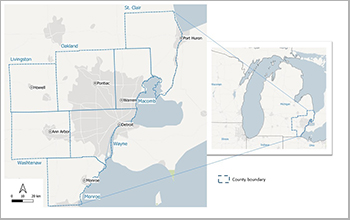
Research News
But urban sprawl fragmented forested lands
August 11, 2020
The extent of both tree canopy and urban sprawl increased in Southeast Michigan between 1985 and 2015, according to a new University of Michigan study that used aerial photos and satellite images to map individual buildings and small patches of street trees.
The U.S. National Science Foundation-funded researchers described the increase in forested area across the region as a positive finding. But their analysis also revealed that the region’s forested lands grew increasingly fragmented, mainly because of increased urban sprawl, which interfered with the ability of plants and animals to disperse across the landscape.
“Our results show that the forested landscapes of Southeast Michigan appear more fragmented and less cohesive in areas experiencing urban sprawl, in accordance with findings worldwide,” said study lead author Dimitrios Gounaridis.
“We found that low-density single-family housing, in particular, had a detrimental effect on adjacent forested landscapes,” he said. “The distance to these built-up patches appears to be a factor in determining the magnitude of the impact.”
The study was published in the journal Landscape Ecology.
The researchers found that the region’s tree cover expanded by 246 square miles, or 1.8%, over the three decades, caused mainly by the maturing of existing trees in older residential neighborhoods and on public lands. “An increase in tree cover is encouraging, especially because of trees’ potential to reduce carbon dioxide levels in the atmosphere,” said Bruce Hamilton, a program director in NSF’s Directorate for Engineering.
During the same period, the amount of land covered by buildings and roads grew in the seven-county Southeast Michigan study area by 12%. The newly developed land covered 130 square miles and included an estimated 335,000 new buildings and an estimated 7,000 miles of new roads.
At first glance, these results might seem paradoxical. How can you increase tree cover in a region while simultaneously constructing more roads and thousands of new buildings?
But most of the newly developed land came from former farmland, not from forested areas. The expansion of the tree canopy was attributed to the maturing of existing trees, along with new trees planted in residential neighborhoods and on public lands, as well as land-conservation efforts.
—
NSF Public Affairs,
researchnews@nsf.gov
Source: NSF News
Brought to you by China News






